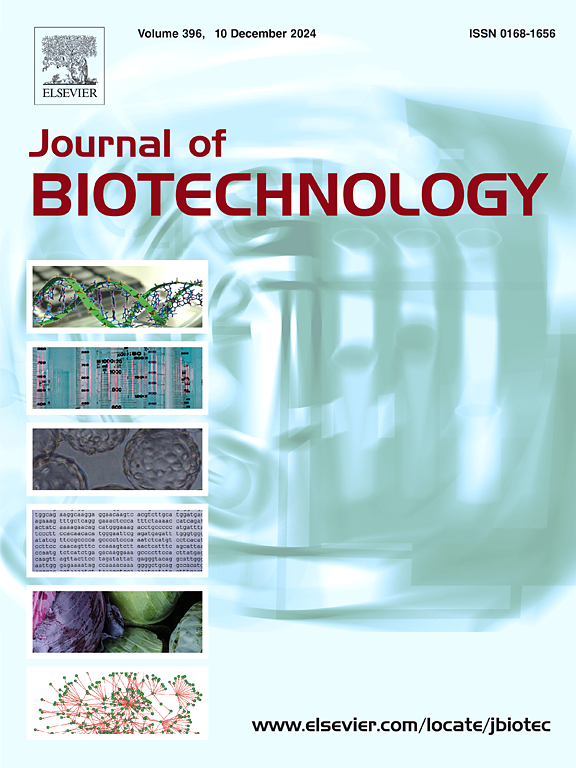Molecular engineering of UnaG: Insights into fluorescence dynamics and biosensor potential
IF 3.9
2区 生物学
Q2 BIOTECHNOLOGY & APPLIED MICROBIOLOGY
引用次数: 0
Abstract
UnaG represents the first ligand-inducible (unconjugated bilirubin) fluorescent protein to be discovered in vertebrates. It was isolated from the muscles of the Japanese eel (Anguilla japonica) and has been shown to emit green fluorescence exclusively when bound to unconjugated bilirubin (UC-BR). This distinctive property of UnaG renders it a promising biosensor candidate for the detection of UC-BR. The sensitive and specific detection of UC-BR is of great importance for clinical diagnosis and treatment. It is imperative to enhance the binding affinity and thermal stability of wild type UnaG for successful clinical applications These proteins may serve as promising candidates for future diagnostic applications, pending validation in biological samples. In this study, Arginine at position R112 and R132 in the UnaG-UC-BR binding site was replaced with Methionine. This was done to regulate the binding affinity of wild-type UnaG protein to UC-BR to a level that could be measured in a physiological context, and to improve its thermal stability. In this study, the positive charge in the relevant binding sites was eliminated and the biophysical changes of these mutations on the UnaG protein were investigated. The secondary structures and thermal melting temperatures of the proteins were analysed by circular dichroism spectroscopy. Excitation and emission wavelengths were determined by fluorescence spectroscopy, while dissociation constants (Kd) were determined by titration studies with UC-BR. The findings indicate that R112M, R132M and R112&132 M mutants exhibited high sensitivity, reaching fluorescence saturation at UC-BR concentrations of ∼10 nM, ∼12 nM and ∼10 nM, respectively. Thermal stability analyses revealed that the R112M&R132M double mutant was the most stable variant, with a melting temperature of 72°C. The results of this study indicate that engineered UnaG variants have the potential to function as high-affinity and stable biosensors for the detection of UC-BR.
UnaG的分子工程:荧光动力学和生物传感器潜力的见解
UnaG是在脊椎动物中发现的第一个配体诱导(非共轭胆红素)荧光蛋白。它是从日本鳗鲡(Anguilla japonica)的肌肉中分离出来的,当与非共轭胆红素(UC-BR)结合时,它被证明只发出绿色荧光。UnaG的这种独特性质使其成为检测UC-BR的有前途的生物传感器候选者。UC-BR的灵敏、特异检测对临床诊断和治疗具有重要意义。为了成功的临床应用,提高野生型UnaG的结合亲和力和热稳定性是必不可少的。这些蛋白可能是未来诊断应用的有希望的候选者,有待于在生物样品中验证。在本研究中,UnaG-UC-BR结合位点R112和R132位置的精氨酸被蛋氨酸取代。这样做是为了将野生型UnaG蛋白与UC-BR的结合亲和力调节到可以在生理环境中测量的水平,并提高其热稳定性。在本研究中,消除了相关结合位点的正电荷,并研究了这些突变对UnaG蛋白的生物物理变化。用圆二色光谱分析了蛋白质的二级结构和热熔温度。荧光光谱法测定激发和发射波长,UC-BR滴定法测定解离常数(Kd)。研究结果表明,R112M、R132M和R112&;132 M突变体表现出高灵敏度,在ucbr浓度分别为~ 10 nM、~ 12 nM和~ 10 nM时达到荧光饱和。热稳定性分析表明,R112M&;R132M双突变体是最稳定的突变体,其熔化温度为72℃。本研究结果表明,工程UnaG变体具有作为检测UC-BR的高亲和力和稳定的生物传感器的潜力。
本文章由计算机程序翻译,如有差异,请以英文原文为准。
求助全文
约1分钟内获得全文
求助全文
来源期刊

Journal of biotechnology
工程技术-生物工程与应用微生物
CiteScore
8.90
自引率
2.40%
发文量
190
审稿时长
45 days
期刊介绍:
The Journal of Biotechnology has an open access mirror journal, the Journal of Biotechnology: X, sharing the same aims and scope, editorial team, submission system and rigorous peer review.
The Journal provides a medium for the rapid publication of both full-length articles and short communications on novel and innovative aspects of biotechnology. The Journal will accept papers ranging from genetic or molecular biological positions to those covering biochemical, chemical or bioprocess engineering aspects as well as computer application of new software concepts, provided that in each case the material is directly relevant to biotechnological systems. Papers presenting information of a multidisciplinary nature that would not be suitable for publication in a journal devoted to a single discipline, are particularly welcome.
 求助内容:
求助内容: 应助结果提醒方式:
应助结果提醒方式:


